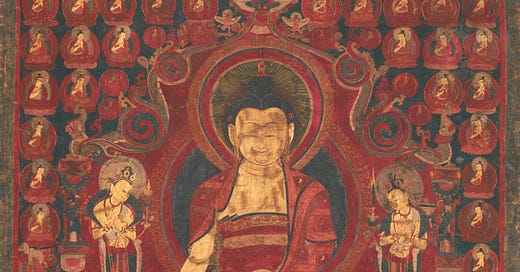Anxiety as Ignorance of the World
Buddhism and Stoicism, plus philosophy as therapy for the soul
My most recent philosophical read has been the insightful Anxiety: A Philosophical Guide by Samir Chopra.
While this is not a proper book review – I will certainly not be rating the book out of 5 or 10 stars – I want to note a few of the genuine strength on display in the text, and then I want to highlight one chapter which I think readers interested in Stoic texts would find particularly interesting.
When someone sets out to write a book about anxiety, there are a variety of paths one could take. First, you could write a self-help book. Along this path you will find many clichés, some banalities, and just a few good points. At the end of this path the author finds a massive pot of gold. Second, you could write a pop psychology book. Along this path, you also find clichés and banalities, but if the author has a sense of pride in their work you’ll find a higher concentration of insights. There is a pot of gold at the end of the path, but not quite large enough to be called massive.
The third option is to write a work of philosophy, understood at least in part in the ancient sense as a kind of therapy for the soul. Ideally there will be few clichés and banalities — but there is also almost never going to be a pot of gold. Samir Chopra chose the third path. He was right to do it, and we all benefit from it. Anxiety: A Philosophical Guide is insightful, sometimes so personal that I want to call it ‘raw’, and a genuinely good read.
Chopra has also chosen to be purposefully broad in focus. While many of the authors Chopra engages with are your standard fare (if you read so-called ‘Continental philosophy’), some are not. The choice to integrate both teachings from the Buddha and insights from the existential theologian Paul Tillich was a good one.
And it is the teachings of the Buddha that I want to discuss, in brief.
Here is how Chopra summarizes the Buddha’s view of anxiety, particularly relating it to the concept of dukkha.
The Buddha taught an acute understanding and acceptance of the world and of our personal identity; once you understood how it “worked” and who and what you were, then human dukkha stood revealed as a species of unnecessary suffering, grounded in a deep, fundamental, metaphysical misunderstanding of the nature of reality. Misplace yourself in this conception of the world, and you would suffer; correct this vision, and you could rescue yourself from a species of acute existential suffering. Buddhism, then, considers anxiety—like anger—a disease to be cured; its practices aim to ameliorate and minimize its impact in our lives.
Like many of the authors Chopra draws on, it seems that the Buddhist view of anxiety is one in which anxiety, while pathological in some sense, is also a part of the ordinary course of being a human being. It is in our nature to be anxious. That is because anxiety comes part and parcel with some of our fundamental characteristics: our rationality, our curiosity, our innate desire to be problem-solvers, our habit of forming and revising plans. All of these contribute to the anxious mind.
But the Buddha also believed that anxiety could be cured — and it could be cured, in part, through understanding the world and understanding yourself. And this, I think, is also the Stoic course of treatment. Our minds may be the cause of our anxiety — but they are also crucial components of the cure.
Consider this quote from the second notebook of Marcus Aurelius’ Meditations:
This thing that I am, whatever we are to call it, is flesh, spirit, and the command center…As one on the point of death, despise the flesh: it’s just blood, bones, and a network of nerves, veins, and arteries. Then consider what spirit is: no more than air, and never constant, continually belching and gulped back in again. So that leaves the third ingredient, the command center. Look at it this way: you’re elderly; put an and to allowing its enslavement; put an end to being tugged here and there like a puppet at the prompting of selfish impulses; put an end to both complaining about your present fate and shrinking from the future.
This is a far-cry from the Buddhist conception of the self — after all, the standard Buddhist view is something like David Hume’s view in the Treatise, in which there is no self. But these are disputes over facts, not methods. It is the similarity in method that is most interesting here.
Both the Stoics and the Buddhists seem to share some common assumptions, similar to what are sometimes called the Four Noble Truths. There is a suffering; this is the uneasiness which Marcus fights against, what the Buddhists call dukkha. There is a cause to our suffering. Our suffering can be ended. There is a path to ending that suffering. And both camps agree that the path involves a kind of metaphysical training — by learning about the world and about our role in the world, we can find peace.
Thus, I think we can say that for both Stoics and Buddhists, anxiety is a kind of ignorance.
This is quick — too quick, in fact. It deserves a much longer treatment in order to be a good comparison. It is very easy to say ‘This view from the West looks like Buddhism’ (or Taoism, Confucianism, etc.). What is more difficult is showing this in any great detail.
More to come, I hope.






Great text, I will definitely check the book! Stoics and Buddhism definitely share some methods, even the philosophy behind is different.
(There's a typo in this sentence “put an and to allowing its enslavement” in Marcus Aurelius Quote)